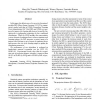Free Online Productivity Tools
i2Speak
i2Symbol
i2OCR
iTex2Img
iWeb2Print
iWeb2Shot
i2Type
iPdf2Split
iPdf2Merge
i2Bopomofo
i2Arabic
i2Style
i2Image
i2PDF
iLatex2Rtf
Sci2ools
90
Voted
ICPR
2002
IEEE
2002
IEEE
Comparative Study on Mirror Image Learning (MIL) and GLVQ
In this paper the effectiveness of a corrective learning algorithm MIL (Mirror Image Learning) [1], [2] is comparatively studied with that of GLVQ (Generalized Learning Vector Quantization) [3]. Both MIL and GLVQ were proposed to improve the learning effectiveness beyond the limitation due to independent estimation of class conditional distributions. While the GLVQ modifies the representative vectors of a pair of confusing classes when recognizing each learning pattern, the MIL generates a mirror image of a pattern which belongs to one of a pair of confusing classes and increases the size of the learning sample to update the distribution parameters. The performance of two algorithms is evaluated on handwritten numeral recognition test for IPTP CDROM1 [4]. Experimental results show that the recognition rate of projection distance classifier is improved from 99.31% to 99.40% by GLVQ and to 99.50% by MIL, respectively.
Computer Vision | Handwritten Numeral Recognition | ICPR 2002 | Learning Algorithm Mil | Learning Effectiveness |
Related Content
| Added | 09 Nov 2009 |
| Updated | 09 Nov 2009 |
| Type | Conference |
| Year | 2002 |
| Where | ICPR |
| Authors | Meng Shi, Tetsushi Wakabayashi, Wataru Ohyama, Fumitaka Kimura |
Comments (0)

